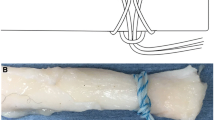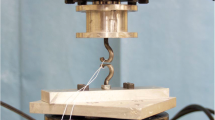Abstract
Purpose
Aim of this paper is to compare the biomechanical properties of the Pretzel knot with the selected arthroscopic knots and to test the mechanical safety of this knot. The hypothesis was that the Pretzel knot may have equal or better mechanical properties than the arthroscopic knots tested in this study.
Methods
SMC, Giant, Dines, Nicky’s, Tennessee Slider knots were chosen for comparison. Original and backed configuration of knots were prepared with no. 2 braided polyester sutures. Cyclic loading and load to failure tests were performed. Parameters tested were loop security, maximum elongation and load at failure. Number of steps needed for preparation of each knot was also recorded. One-way ANOVA for repeated measures was performed for all knots.
Results
Steps needed for preparation were 2 for Pretzel and Tennessee Slider, 3 for Nicky’s, SMC and Dines and 4 for Giant. The Pretzel knot in original configuration had significantly better loop security compared to SMC, Dines, Nicky’s and Tennessee knots (P = 0.01). Loads at failure were not significantly different between knots in their original configurations. Giant and Dines knots showed better maximum elongations in cyclic loading (P = 0.0059) and load to failure tests (P = 0.0001). Backing up the knots with 3-RHAPs eliminated most of these significant differences.
Conclusions
Clinically, simplicity and safety are two important components in arthroscopic knot tying. Despite its simple configuration, Pretzel knot has some similar and increased mechanical properties compared to the tested knots that are widely used.






Similar content being viewed by others
References
Abbi G, Espinoza L, Odell T, Mahar A, Pedowitz R (2006) Evaluation of 5 knots and 2 suture materials for arthroscopic rotator cuff repair; very strong sutures can still slip. Arthroscopy 22:38–43
Barber FA, Herbert MA, Beavis RC (2009) Cyclic load and failure behavior of arthroscopic knots and high strength sutures. Arthroscopy 25:192–199
Baumgarten KM, Brody MD, Silva MJ, Wright RW (2008) An in vitro analysis of the mechanical properties of 16 arthroscopic knots. Knee Surg Sports Traumatol Arthrosc 16:957–966
Buess E, Steuber KU, Waibl B (2005) Open versus arthroscopic rotator cuff repair: a comparative view of 96 cases. Arthroscopy 21:597–604
Burkhart SS, Johnson TC, Wirth MA, Athanasiou KA (1997) Cyclic loading of transosseous rotator cuff repairs: tension overload as a possible cause of failure. Arthroscopy 13:172–176
Burkhart SS, Wirth MA, Simonick M, Salem D, Lanctot D, Athanasiou K (1998) Loop security as a determinant of tissue fixation security. Arthroscopy 14:773–776
Dahl KA, Patton DJ, Dai Q, Wongworawat MD (2010) Biomechanical characteristics of 9 arthroscopic knots. Arthroscopy 26:813–818
De Beer JF, van Rooyen K, Boezaart AP (1998) Nicky’s knot—a new slip knot for arthroscopic surgery. Arthroscopy 14:109–110
Dines JS, Moynihan D, Uggen C, Dines DM (2008) The DMD knot: a new locking, flip knot. J Surg Orthop Adv 17:115–118
Elkousy HA, Sekiya JK, Stabile KJ, Mcmahon PJ (2005) A biomechanical comparison of arthroscopic sliding and sliding-locking knots. Arthroscopy 21:204–210
Fleega BA, Sokkar SH (1999) The giant knot: a new one-way selflocking secured arthroscopic slip knot. Arthroscopy 15:451–452
Gerber C, Schneeberger AG, Beck M, Schlegel U (1994) Mechanical strength of repairs of the rotator cuff. J Bone J Surg Br 76:371–380
Hassinger SM, Wongworawat MD, Hechanova JW (2006) Biomechanical characteristics of 10 arthroscopic knots. Arthroscopy 22:827–832
Karahan M, Akgun U, Espregueira-Mendes J (2010) The Pretzel knot: a new simple locking slip-knot. Knee Surg Sports Traumatol Arthrosc 18:412–414
Kim SH, Ha KI (2000) The SMC knot—a new slip knot with locking mechanism. Arthroscopy 16:563–565
Kim SH, Ha KI, Kim SH, Kim JS (2001) Significance of the internal locking mechanism for loop security enhancement in the arthroscopic knot. Arthroscopy 17:850–855
Kim SH, Yoo JC, Wang JH, Choi KW, Bae TS, Lee CY (2005) Arthroscopic sliding knot: how many additional half-hitches are really needed? Arthroscopy 21:405–411
Lee TQ, Matsuura PA, Fogolin RP, Lin AC, Kim D, McMahon PJ (2001) Arthroscopic suture tying: a comparison of knot types and suture materials. Arthroscopy 17:348–352
Loutzenheiser TD, Harryman DT II, Yung SW, France MP, Sidles JA (1995) Optimizing arthroscopic knots. Arthroscopy 11:199–206
Mishra DK, Cannon WD, Lucas DJ, Belzer JP (1997) Elongation of arthroscopic tied knots. Am J Sports Med 25:113–117
Nottage WM, Lieurance RK (1999) Arthroscopic knot tying techniques. Arthroscopy 15:515–521
Punjabi VM, Bokor DJ, Pelletier MH, Walsh WR (2011) The effect on loop elongation and stress relaxation during longitudinal loading of fiberwire in shoulder arthroscopic knots. Arthroscopy 27:750–754
Sileo MJ, Lee SJ, Kremenic IJ, Orishimo K, Ben-Avi S, McHugh M, Nicholas SJ (2009) Biomechanical comparison of a knotless suture anchor with standard suture anchor in the repair of type II SLAP tears. Arthroscopy 25:348–354
Acknowledgment
Authors thank Michele Haus Karahan for her contribution in this paper.
Author information
Authors and Affiliations
Corresponding author
Rights and permissions
About this article
Cite this article
Karahan, M., Akgun, U., Turkoglu, A. et al. Pretzel knot compared with standard suture knots. Knee Surg Sports Traumatol Arthrosc 20, 2302–2306 (2012). https://doi.org/10.1007/s00167-011-1788-2
Received:
Accepted:
Published:
Issue Date:
DOI: https://doi.org/10.1007/s00167-011-1788-2




